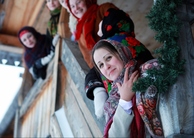From the Field:Rural-Urban Migration and Agricultural Transformation in India: Observing the Impact on Childhood Migration From Bihar to New Delhi
By
2013, Vol. 5 No. 10 | pg. 1/4 | »
IN THIS ARTICLE
KEYWORDS
AbstractLarge-scale rural to urban migrations have been occurring in India in record numbers within the last thirty years, inflating the populations of urban centers, such as Delhi and Mumbai. Within these streams of migrations, the number of youth leaving for cities has also dramatically increased. Simultaneously in rural India, deep agricultural transformations are taking place, altering the landscape, the available opportunities, and ultimately the livelihoods of its people. This paper addresses the agricultural transformations occurring in India in relation to the migration of children from rural to urban centers. With a shifting system of landholding, climatic changes, increasing mechanization and industrialization of agriculture, and new development projects, the agrarian system in rural India is rapidly changing. Based on fieldwork conducted in India, interviews with local experts and urban/rural informants, this paper draws connections between the transformations occuring in the agricultural sector with the increase in the number of children running away to major cities. What is encouraging the migration of youth from rural areas of Bihar? What transformations can we see as catalysts for a growing trend of running away? The answers to these questions are excruciatingly complex, multi-dimensional puzzles that lend themselves to issues of history, politics, socioeconomics, and culture. This paper focuses primarily on one piece of this multifaceted pattern of migration: the agricultural antecedents to childhood migration from Bihar to Delhi. Additionally, the entanglements that link agriculture transformations to other complex processes are explored. It is important to note that while agricultural transformations have contributed to childhood migration, there are also complex networks and relationships that tie agriculture to many other historical, socioeconomic, and religious devices, which are all simultaneously at work. These issues are henceforth explored. Fieldwork & MethodologyFieldwork was conducted in India over the course of three months during the summer of 2012. Primary areas of study were in the Indian capital of New Delhi and Bihar state in northeast India. The first month of fieldwork was spent in Delhi, working closely with street children as well as with non-governmental organizations (NGOs) that provide care and services to many former and present-day street children. While a major portion of fieldwork in Delhi was spent at railway platforms, temple markets, and major tourist areas—locations where many street children live—another piece of my time in Delhi was spent at SBT, an NGO that has been a presence in Delhi among street children for over twenty years. They have numerous shelters, contact points, and representatives that provide safety and care to many of the children. I volunteered at a major shelter of SBT, teaching children rudimentary English skills and computer software and technology. At the same time, I was able to gain the trust of these children and begin to learn of their histories and troubles. In this process, I was able to gain insight into many of my initial research questions as well as sift through the pieces I would hear from children living on the streets. My time in Delhi provided me with a roadmap for understanding children’s livelihoods and survival mechanisms on the streets, their networking and social organization, while giving me a foundation to make sense of past rural migrations. In Bihar state, I spent time primarily in two major districts: Sitamarhi, an area along the Nepal border becoming increasingly notorious for child trafficking; and Samastipur, a central town located on the banks of the Gandaki River (Sakha, 2012). In these towns, I visited nearby villages, speaking with local villagers, both young and old, about issues of running away, agricultural transformations within the villages, and their impressions of rural and urban areas. In addition, I met with organizers and children from local NGOs that were working to address issues of child labor and trafficking from rural source areas to major cities. In the last days of my time in Bihar, I spent time in the capital, Patna, speaking with children in a local NGO as well as on the major Patna railways junction. In Bihar, I was able to connect the experiences in Delhi with the contemporary issues of rural life within a major source area for runaway children. This piece of my study provided me with essential linkages between the rural and urban, contributing to my understanding of the complexities of childhood migration. In all pieces of my research, participant-observation and interviews were vital. Active participation in the NGOs and in rural villages proved critical for making sense of my research questions. Interviews tended to be loosely scripted while others were informal conversations. These allowed me to find specific, detailed first-person accounts of my primary foci, giving me important insight into my research questions. Lastly, much of my research was conducted alongside my primary informant and translator, Khushboo Jain, a Ph.D candidate studying sociology at the University of Delhi. While my Hindi skills were proficient enough to hold a very basic conversation, Khushboo’s translations allowed me to plunge further into the critical issues of my research. Her knowledge of Delhi’s street children and organizational networks along with her unwavering passion for making a difference in the lives of the children of Delhi proved essential. Her input was critical, constructive, invaluable, and a major force in the success of this project. The Street ChildBefore exploring the roots of childhood migration in rural areas, it is vital to create definitive boundaries for what we term “street children.” As Panter-Brick notes, street children’s situations are far from homogenous and these children come from a wide variety of backgrounds and circumstances, so much so that the term fails to lend itself to encompass the diverse lifestyles of children who are on or of the street (Panter-Brick 2002). Children come to Delhi through countless modes including family migrations, alone as solo children, or via trafficking into a workplace environment, among others. It is impossible to encompass these diverse passageways to street life in one term. These complexities extend further into the representation of identity on the street itself, in which children make sense of their self—challenging their so-called status as “urchins” or “street dwellers.” No child conforms to this affixed identity. Instead, they resist it through day to day actions and a unique system of livelihood making. In Delhi, estimates of the number of street children are wide ranging. NGO surveys debate what exactly constitutes a street child, meaning estimated numbers of street children in India tend to vary. A recent Save the Children study, titled Surviving the Streets found over 50,000 children to be considered street kids, with over 70% of those children known to have a home somewhere in Delhi (Bhaskaran & Mehta, 2011). Other estimates from SBT state there to be upwards of 100,000 street children in Delhi. This is part of a much larger, growing number of street children in India, where estimates claim there to be almost 18 million street children (Butterflies, 2011b). “Ragpicking” along the tracks in Old Delhi Station  Delhi’s street kids live in a variety of ways in order to maintain their livelihoods. For children living in railway stations and platforms, a frequent occupation is “ragpicking,” which involves the collection of plastic bottles in railcars using large nylon sacks (Steinberg, 2012).1 The children work usually with others on their platform, typically pulling together the total amount of bottles at the end, where they will then be brought to a middle man who pays the children. The middle man will then return the bottles to a recycling center where they are reprocessed. Other options for street children to earn typically involve food service, such as in dhabas, tea stalls, and restaurants, while some become domestic servants for civil society (Butterflies, 2011a). For girls, however, being in the public eye puts the family’s honor in question, while raising questions of impropriety. Frequently, girls who enter the urban landscape will quickly be swept up and recruited into elaborate prostitution circles (Huberman, 2006). While girls and boys have differing livelihood strategies on the streets due to cultural expectations and norms, one must look beyond material livelihoods to see deeper connections on the street. One fails to see the complex relationships and network that exists among street children if they do not look beyond money. Alessandro Conticini’s insight into the children of Bangladesh should be noted here: For street children in Dhaka, “a feeling of love and trusted friends” and “cooperation” were found to be the most important things in daily life (Conticini, 2007). Supportive social networks and relationships can be found across all groups of children on the streets of Delhi. Children on the railways tend to identify with a particular platform and have a certain social circle they will share money, food, and sometimes drugs with.2 In temple markets, such as Kalkaji Mandir in Delhi, these tight knit social circles also exist. Children will sit on the steps of the market begging for handouts of money and food. After collection, the children will head to one of pathways out of the market where they will share the sum of their handouts, talk, and simply play around. The livelihoods of street children extend beyond survival through their complex interrelationships and social networks. These children promote social inclusion in a structure that has historically rejected their presence, binding together with others who have had similar experiences.Continued on Next Page » Suggested Reading from Inquiries Journal
Inquiries Journal provides undergraduate and graduate students around the world a platform for the wide dissemination of academic work over a range of core disciplines. Representing the work of students from hundreds of institutions around the globe, Inquiries Journal's large database of academic articles is completely free. Learn more | Blog | Submit Latest in Anthropology |














